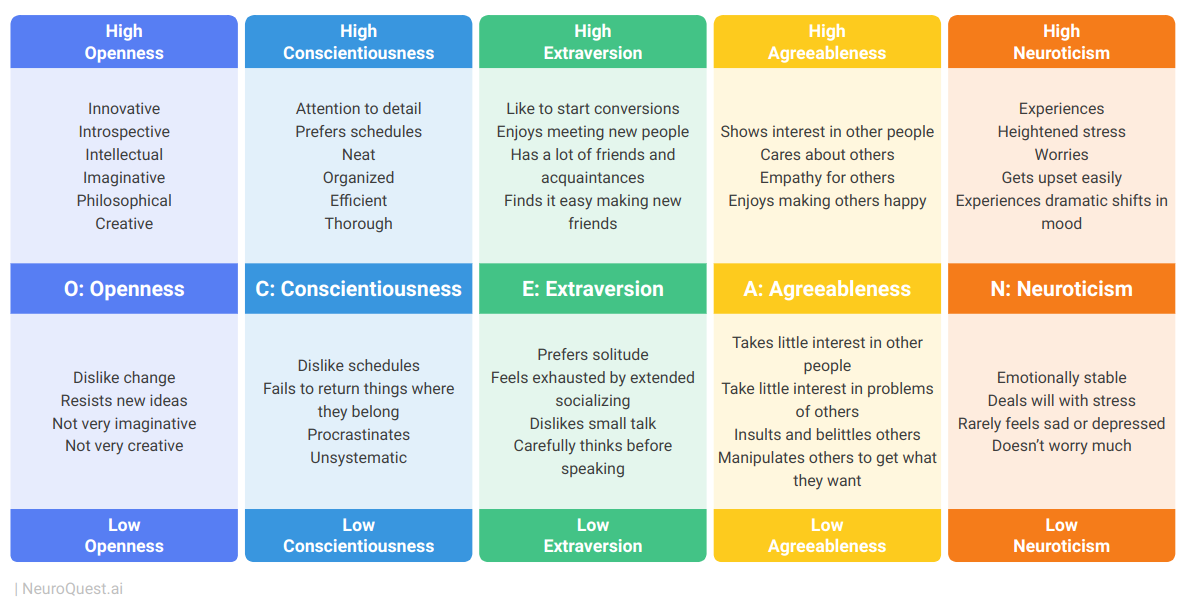Beginner’s Guide To Big Five Personality Traits
The Big Five Model, also known as the Five-Factor Model, is one of the most widely accepted personality theories in the field of psychology. This model posits that personality can be distilled into five core factors, conveniently represented by the acronym OCEAN or CANOE.
The History Of The Big Five Personality Traits
Numerous independent researchers played pivotal roles in formulating the modern understanding of the Big Five personality traits. This journey traces its origins to 1936 when Gordon Allport and Henry Odbert compiled an extensive list of 4.500 terms pertaining to personality characteristics.
Their comprehensive compilation laid the groundwork for subsequent psychologists to identify fundamental factors within the realm of personality traits. Subsequently, in the 1940s, Raymond Cattell and his colleagues employed a statistical technique known as factor analysis to further distill Allport and Odbert’s extensive list.
Through their rigorous analytical efforts, they succeeded in whittling down the original list of 4.500 terms to a mere sixteen distinct traits. This marked a significant advancement in the quest to define and categorize personality traits.
Building upon Cattell’s work, a succession of psychologists continued to refine the theory, ultimately arriving at the five core traits that comprise the Big Five as it is recognized today. Among these influential figures, Donald Fiske, Goldberg, McCrae, Smith, John A. Johnson, Brian R. Little, and Costa stand out for their contributions to the development of the Big Five personality traits.
Scores
Scores must be interpreted carefully; there is no individual who embodies 100% openness or 0%. Similarly, when considering low values for neuroticism, these indicate a positive trait, reflecting a person who exhibits greater emotional stability.

Openness to Experience
This factor measures an individual’s receptivity to novel experiences and ideas. Those who score high in openness tend to be imaginative, curious, and open to exploring new concepts. This trait is associated with creativity and open-mindedness.
High Score:
Individuals with high openness scores are often creative, imaginative, eager to try new things, and receptive to fresh ideas.
Low Score:
Those with low scores on this scale may resist change, prefer familiar routines, and exhibit more traditional thought patterns.
Conscientiousness
Conscientiousness reflects a person’s level of organization, self-discipline, and goal-oriented behavior. Individuals with high conscientiousness scores are typically meticulous, responsible, and reliable. They tend to set and achieve goals while maintaining structured lives.
High Score:
Those scoring high in conscientiousness are well-prepared, organized, persistent, goal-oriented, self-aware, and proficient in time management.
Low Score:
Individuals with lower scores may exhibit lower levels of organization, be more impulsive, prone to procrastination, and less inclined toward structured approaches.
Extraversion
Extraversion gauges an individual’s social orientation and their degree of extroversion or introversion. Those with high extraversion are often sociable, talkative, and comfortable in group settings. In contrast, individuals with low extraversion (introverts) tend to be more reserved and may prefer solitude or smaller, intimate gatherings.
High Score:
Individuals scoring high in extraversion tend to be adept at making friends, enjoy socializing, and are often outgoing, seeking excitement and adventure.
Low Score:
Those with low extraversion scores may avoid large social gatherings, be more reserved, find it challenging to engage in small talk, and prefer solitude.
Agreeableness
This factor assesses an individual’s level of agreeableness or how easygoing they are. High scores in agreeableness indicate a cooperative, understanding, and adaptable nature. Agreeable individuals are often compassionate, trustworthy, and compatible with others.
High Score:
Individuals with high agreeableness scores tend to be honest, cooperative, caring, and trusting. They may seek to resolve conflicts and are often seen as approachable and trustworthy.
Low Score:
Those with lower scores may exhibit self-centered behavior, have less compassion for others, be more stubborn, and find it challenging to forgive.
Neuroticism
Neuroticism measures a person’s emotional stability and resilience in the face of adversity. High neuroticism scores suggest a tendency to be more affected by negative outcomes and stressors. This trait reflects emotional intelligence and coping strategies.
High Score:
Individuals with high neuroticism scores may experience frequent stress, mood swings, and difficulty coping with challenging situations. They may exhibit feelings of insecurity, self-blame, and frustration.
Low Score:
Those with low neuroticism scores tend to be more optimistic, less prone to worry, emotionally stable, and confident in their ability to remain composed in stressful situations.
The Reliability of the Big Five Personality Trait Model
The Big Five Model has been widely embraced by various professionals, including researchers, theorists, and business leaders. It has consistently demonstrated its effectiveness in yielding valuable insights. However, studies have shown that these personality traits tend to be relatively stable in adulthood, with gradual changes occurring over time.